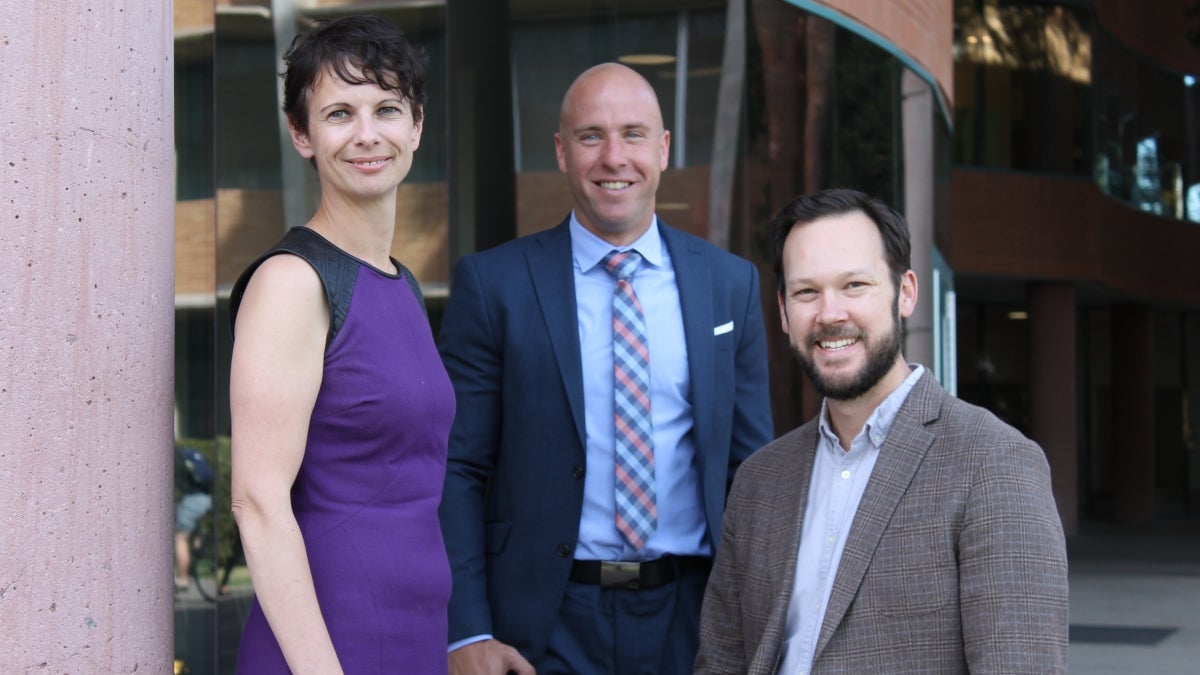Helping smart cities use big data, connected technology for good

Diana Bowman and Thad Miller, co-directors of the Center for Smart Cities and Regions, with Dominic Papa, executive director and co-founder of the Institute of Digital Progress. Photo by Marissa Huth/School for the Future of Innovation in Society
How should urban planners and policy-makers manage autonomous vehicles? How can innovators and entrepreneurs develop new technologies that respond to the needs of communities and produce better health outcomes? How can private and public data protect and empower vulnerable populations?
These are some of the questions Arizona State University's new Center for Smart Cities and Regions will address, as it works to improve the ability of communities to leverage the Internet of Things and other new technologies to advance their economic, social, cultural and overall health.
Working closely with policy-makers, city planners, entrepreneurs, industry leaders and the public, the center will enhance the capacity of cities and regions to use data analytics and emerging technologies.
"We increasingly have the tools and the technologies to address local, regional and global problems,” said Diana Bowman, co-director of the center and associate professor with the School for the Future of Innovation in Society and the Sandra Day O'Connor College of Law. “However, unless these technologies are developed and deployed in a way that is responsive and responsible, their potential benefits are unlikely to be realized.”
One of the center's first partnerships will be with the Institute of Digital Progress and the Greater Phoenix Economic Council who, on March 28, announced the Greater Phoenix Smart Region initiative at the Smart Cities Connect conference in Kansas City. On stage, Dominic Papa, executive director of the Institute of Digital Progress, and Chris Camacho, president and CEO of the Greater Phoenix Economic Council, spoke of the center and the ways in which the entities will be able to work together.
“By partnering with the Center for Smart Cities and Regions at Arizona State University, the regional effort will be able to continually refine smart technology solutions. This partnership will enable the region to harness the knowledge and capacity of the most innovative university in the nation," Papa said.
Additional current projects include:
ASU as Smart Living Lab — The Center for Smart Cities and Regions will work with the ASU University Technology Office to build a “smart campus” that makes the ASU community experience better. For example, the center is collaborating with the Ira A. Fulton Schools of Engineering in examining the use of Amazon Echo devices in use by engineering students residing in Tooker House.
Governance of Autonomous Vehicles — The center is working is working with cities, including Tempe, to manage the risks and benefits of self-driving cars.
Educational Programs — The center will develop of educational programs around smart technology with the School for the Future of Innovation in Society, including the Smart City Academy, graduate certificates and concentrations.
Opening Pathways for Discovery, Research, and Innovation in Health — A collaboration between patients and traditional researchers to explore the processes around discovery, research, and innovation in health and healthcare where patients have created and shared a closed-loop artificial pancreas. The project, led by a patient as principal investigator, is supported with grant funding by the Robert Wood Johnson Foundation.
“Rapidly emerging technologies, like autonomous vehicles, present both risks and opportunities to cities,” said center co-director Thad Miller, assistant professor with the School for the Future of Innovation in Society and the Polytechnic School at ASU. “[The center] works with city policy-makers and planners — as well as industry and the public — to help them leverage technology to meet their goals and community needs.”
The center will take a multi-disciplinary approach to collaborative research by bridging the gap between science and technology research and urban governance.
To learn more and become involved with the projects and initiatives, visit the Center for Smart Cities and Regions.
More Science and technology

Lucy's lasting legacy: Donald Johanson reflects on the discovery of a lifetime
Fifty years ago, in the dusty hills of Hadar, Ethiopia, a young paleoanthropologist, Donald Johanson, discovered what would…

ASU and Deca Technologies selected to lead $100M SHIELD USA project to strengthen U.S. semiconductor packaging capabilities
The National Institute of Standards and Technology — part of the U.S. Department of Commerce — announced today that it plans to…

From food crops to cancer clinics: Lessons in extermination resistance
Just as crop-devouring insects evolve to resist pesticides, cancer cells can increase their lethality by developing resistance to…